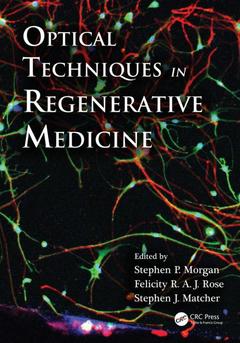Description
Optical Techniques in Regenerative Medicine
Coordinators: Morgan Stephen P., Rose Felicity R., Matcher Stephen J.
Language: English
Subjects for Optical Techniques in Regenerative Medicine:
Keywords
Ch Ap; Regenerative Medicine; optical techniques applied to regenerative medicine; Tissue Engineering; tissue engineered products; Photoacoustic Tomography; optical coherence tomography and high-resolution 3D imaging in tissues and scaffolds; Polarization Sensitive Optical Coherence Tomography; macroscopic imaging; SHG Imaging; non-destructive analytical techniques in regenerative medicine; Speckle Pattern; second harmonic generation microscopy; Photoacoustic Microscopy; regenerative medicine and biophotonics; Bioluminescence Imaging; Raman spectroscopy; Scattering Coecient; SHG Microscopy; Speckle Contrast; Ce Ll; OCT Image; Stem Cells; SHG Intensity; Laser Speckle Imaging; Car Microscopy; PA Signal; SHG Signal; X-ray CT; Inverse Power Law; SHG Emission; Laser Speckle
Publication date: 08-2013
· 17.8x25.4 cm · Hardback
Publication date: 11-2018
· 17.8x25.4 cm · Paperback
Description
/li>Contents
/li>Biography
/li>
In regenerative medicine, tissue engineers largely rely on destructive and time-consuming techniques that do not allow in situ and spatial monitoring of tissue growth. Furthermore, once the therapy is implanted in the patient, clinicians are often unable to monitor what is happening in the body. To tackle these barriers, optical techniques have been developed to image and characterize many tissue properties, fabricate tissue engineering scaffolds, and characterize the properties of the scaffolds.
Optical Techniques in Regenerative Medicine illustrates how to use optical imaging techniques and instrumentation for the fabrication, assessment, and longitudinal monitoring of regenerative medicine therapies. The book covers optical coherence tomography, acousto-optic imaging, Raman spectroscopy, machine vision, bioluminescence, second harmonic generation microscopy, multi-photon microscopy, coherent anti-Stokes Raman scattering, fluorescence spectroscopy, and light scattering spectroscopy. Each chapter provides an overview of a particular technique, its advantages and limitations in terms of structural and functional information, and examples of applications in regenerative medicine.
The future evolution of regenerative medicine from academic research to viable clinical alternatives to conventional treatments is dependent on the development of non-destructive analytical techniques that can elucidate the stages of tissue development both in vitro and in vivo as well as track the fate of cells following injection. This practical book demonstrates the vital role of optical techniques in the dynamic field of regenerative medicine. It guides regenerative medicine researchers toward finding the most appropriate technique for their applications and helps biophotonics researchers see where their technologies can be applied.
Introduction and Background: The Role of Optical Techniques in Regenerative Medicine. Optical Microscopy in Regenerative Medicine: Fluorescence Microscopy. Second-Harmonic Generation. Two-Photon Polymerization for Tissue-Engineered Scaffold Fabrication. In Situ Microscopy. Optical Spectroscopy in Regenerative Medicine: Light Scattering as Polarization Spectroscopy. Fluorescence Spectroscopy. Raman Spectroscopy. Optical Tomography in Regenerative Medicine: Optical Transillumination and Projection Tomography for Multidimensional Mesoscopic Imaging. Optical Coherence Tomography: Overview and Applications. Application of Polarization-Sensitive OCT and Doppler OCT in Tissue Engineering. Photoacoustic Tomography. Ultrasound-Modulated Optical Tomography. Optical Macroscopic Imaging in Regenerative Medicine: Macroscopic Imaging in Regenerative Medicine. Bioluminescence Imaging. Index.
Stephen P. Morgan, PhD, is a professor in biomedical engineering at the University of Nottingham. Since 1992, he has been developing novel optical techniques for imaging and spectroscopy of tissues, with a particular interest in microcirculation. The imaging devices have been used in clinical studies and have led to a blood flow imager marketed under license to Moor Instruments. His other research interests include developing novel methods of imaging and sensing in regenerative medicine for in vivo and in vitro tissues.
Felicity R.A.J. Rose, PhD, is an associate professor in tissue engineering at the University of Nottingham. Her research focuses on developing materials that can control stem and differentiated cell behavior during the tissue regeneration process to develop in vivo-like in vitro models for safety, toxicity, and drug screening applications and ultimately tissues for transplantation.
Stephen J. Matcher, PhD, is a reader in biomedical engineering at the University of Sheffield. Since 1992, he has conducted research on the use of optical techniques to characterize tissue structure and function. He has developed optical and near-infrared spectroscopy as a tool for the non-invasive measurement of tissue oxygenation. His current research focuses on the use of optical coherence tomography and non-linear microscopy to characterize the structure of native biological tissues and tissue-engineered replacements.




